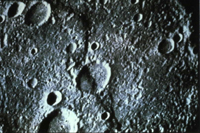Humans can destroy Moon trying to produce helium-3 solar isotope
There is a dangerous tendency in the Russian manned space technology and exploration. Some scientists believe that the extraction of natural resources on the Moon should be viewed as a main purpose of the lunar program. The mining of helium-3, the “solar isotope, on Earth’s natural satellite, is the cornerstone of such a concept. Helium-3 used as a thermonuclear fuel is alleged to be capable of providing mankind with immense advantages in terms of energy. Many an expert have already expressed their skepticism about a helium mining project on the Moon, stressing the point that it would entail astronomical costs. More importantly, the costs would be totally unjustified. Suffice it to say, that 100 million tons of lunar soil would have to be processed for the production of one ton of the isotope.

It is still unclear what is to be done about helium-3 should the isotope be delivered to Earth. Further development of reactors running on deuterium and tritium is currently the most promising and feasible area of research in thermonuclear power engineering. Both deuterium and tritium occur in abundance in the ocean. One of such reactors, the International Thermonuclear Experimental Reactor, is being built in France.
In August 2005, the French researcher P. E. Schtott published an article in the British journal Physics of Plasma and Controlled Reaction. He pointed out that “even under the most favorable circumstances possible the ignition of reaction (of deuterium and helium-3) would require… much higher plasma characteristics than those necessary for triggering the reaction of deuterium and tritium.” Academician Evgeny Velikhov, president of the Kurchatov Institute, a Russian research center, shares the viewpoint: “We need to learn how to burn helium before we start bringing it down to Earth. We don’t have to go to the Moon for doing so.”
It is noteworthy that John Marburger, director of the Office of Science and Technology Policy at the White House, made a special reference to the controversial issue of helium production while delivering a speech at the American Aeronautical Society on March 15, 2006. His speech concerned the ways of attracting private companies to the implementation of the officially declared U.S. lunar exploration program. “I’m not talking about the production of helium-3 for the purpose of using it as a fuel for a thermonuclear reactor. I have my doubts that the project will ever pay off,” said Marburger.
The plans for mining of helium-3 on the Moon may divert significant intellectual, production and economic capabilities of the country from the implementation of more feasible and less costly space programs e.g. a manned space mission to Mars. Academician Roald Sagdeyev, the former director of the Institute of Space Studies, is confident that “today’s intentions to mine natural resources on the Moon can utterly discredit the manned space exploration and technology in the eyes of both the taxpayers and politicians. It will be seen as a kind of cardsharping aimed at uncontrolled and unaccounted appropriation of colossal budget funds.”
Nezavisimaya Gazeta
Translated by Guerman Grachev
Pravda.ru
Subscribe to Pravda.Ru Telegram channel, Facebook, RSS!


